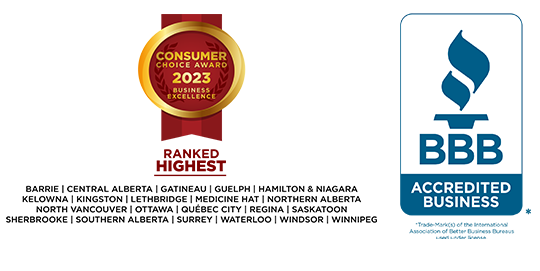How To Calculate And Manage Your Debt
2020-01-21 minute read
Anyone with debt — whether it is a small or large amount — must take time to mange it. The larger your debt load and the more creditors you have, the more difficult this will be. The following are some tips to make this process easier, less stressful and more effective for reaching your goals.

Make a List of Your Debts
First, you need to figure out how much you owe and to whom. Start by obtaining a free credit report from Equifax and Transunion. These credit bureaus will have detailed information about your credit accounts, their payment status and whether any are currently in collections. Each service may have different information, so contact both.
Next, pull together your own records. Most creditors will send you a monthly statement outlining the total amount owing, minimum monthly payment and interest rate. If you’re not able to locate this information, your creditors may have digital copies available online. Otherwise, you can call to request a copy.
Compile all this information in a computer spreadsheet or personal financial software such as Quicken, Microsoft Money or Quickbooks.
Figure Out How Much Your Debt is Costing You
Here’s where a running tally in a spreadsheet or financial software becomes very useful — it puts you face to face with a running tally of your total debt, monthly payments and interest charges. Not only will this help visualize your progress, but also reveal why it sometimes feels like you’re fighting an uphill battle.
You might be surprised by how much of your minimum payment is paying interest only. In fact, some creditors offer a minimum payment that covers only the interest portion of your debt.
The Government of Canada offers a useful tool to help determine how much credit card debt will cost you over the long term. The site also includes several other calculators, such as the mortgage calculator and the vehicle lease or buy calculator, to help you determine whether you can realistically afford new debt or financing options.
Understand Your Debt-to-Income Ratio (DTI)
Your DTI is a representation (measured in percent) of how much of your income goes to debt payments — or, how much you owe compared to what you earn. There are two ways to calculate this, and it’s best to use both to get the complete picture of your debt situation.
Method 1: Monthly Payments
Add all your monthly debt payments and divide the total by your gross monthly income (before taxes and deductions) and multiply by 100. According to the Financial Consumer Agency of Canada, you want to keep this number below 40 percent.
Method 2: Annual Total
First, add the total value of all your debts. Next, calculate your total annual disposable income (what you earn after taxes, bills, debt payments, etc.). Finally, divide your disposable income by the total debt value and multiply by 100. The average annual DTI in Canada is 170%; rates are higher in Vancouver (242%) and Toronto (208%) largely due to the increased cost of housing.
Pay Bills on Time and at Least the Required Minimum Payment
Most creditors require you make a minimum payment by a specific date each month. It’s critical you keep up with these — missing or late payments may cause creditors to take corrective action. Many credit card and financing agreements allow creditors to increase interest rates, charge a financial penalty or take legal action. That is in addition to the damage it will cause to your credit score.
Choose a Debt Repayment Strategy
The strategy you choose to pay down your debt matters less than whether you can commit to it over the long term. Some factors you’ll want to consider in your approach include (1) fitting within your monthly budget, (2) keeping you motivated and (3) reducing the total overall cost.
The three most common methods include:
Pay off debts equally — Prepare a budget for your monthly household expenses. Include an amount for debt repayment. Ideally this will be enough to pay both the interest and a portion of the principal balance. Keep in mind the timing and value of your minimum payments and how these relate to your pay periods and other bill payments.
Avalanche (pay off the highest interest rate first)* — Determine how much you can contribute toward debt repayment each month. Pay only the minimum payment on except the debt with the highest interest rate — where you’ll focus most of of your debt repayment budget. Once you’ve paid it off, move onto the debt with the next highest interest rate, and so on.
*This is by far the most cost-effective approach over the lifetime of your debt.
Snowball (pay off the smallest debt first)** — Determine how much you can contribute toward debt repayment each month. Pay only the minimum payment on all except the debt with the smallest balance — where you’ll focus most of your debt repayment budget. Once you’ve paid it off, move onto the debt with the next smallest balance, and so on.
**A study at Boston University found this method had the greatest success rate of the various debt repayment strategies. It may not make sense from a financial point of view, but the psychology of small wins helps build the momentum, motivation and consistency required to keep moving forward.
Note that succeeding with any methods requires you stop using the credit accounts you are trying to pay off. Otherwise your efforts will be counterproductive at best and could potentially inch you toward an insolvency situation at worst.
Life-Changing Debt Solutions
Managing your debt can seem overwhelming, but it doesn’t have to be. Simple steps such as tracking your outstanding balances and committing to a repayment strategy can often be enough to help you turn your situation around. However, if you feel overwhelmed, have been missing payments or feel like you’ve tried everything and aren’t getting anywhere with your debt, there are still opportunities to get the relief you need and deserve.
Licensed Insolvency Trustees offer a Free Confidential Consultation to review your finances, discuss your goals and help identify opportunities for you to get the financial fresh start you need and deserve. You may qualify for a Life-Changing Debt Solution such as Bankruptcy or a Consumer Proposal, which could help you become debt free in as little as nine months. You may also benefit from referrals to other services and opportunities to help address the route cause of your debt and break the cycle for good.
No matter your options, a Licensed Insolvency Trustee will make sure you have the information and assistance you need to make the best choice for your unique situation and get on the fast track to becoming debt free.

